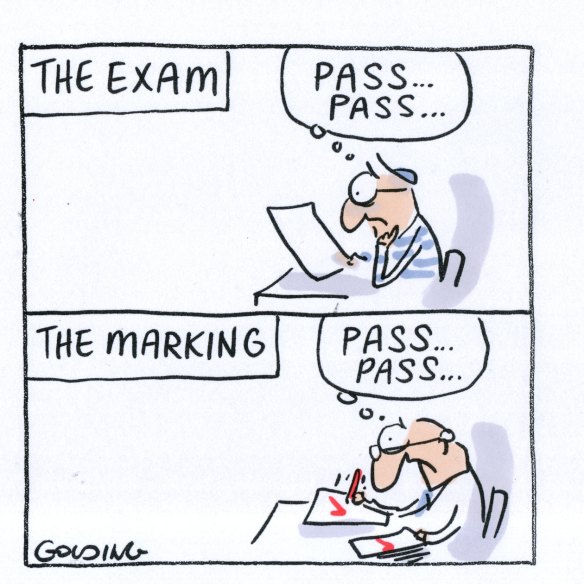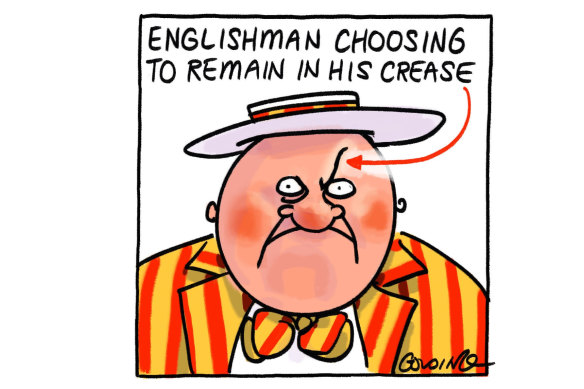This was published 2 years ago
‘Total overhaul needed’: Time for an exam on inequity between schools
There is no doubt some students need special assistance at exam time (“One in 10 HSC students seeks exam lifeline”, July 6). The numbers tell a different story. High-fee private schools can afford to employ someone to identify, facilitate and process the applications. This would seem to be happening with a whopping 25 per cent now gaining assistance. The flow-on effect is that these students, when they move on to university, then have the same expectation that assignment extensions, exam special provisions and the like will be available to ensure they have the best chance of passing. The system needs a total overhaul. Michael Blissenden, Dural

Illustration: Matt GoldingCredit:
The Association of Independent Schools must be working in an alternative universe if they cannot see the reasons why all schools do not apply for special HSC provisions at an equal rate. The data published clearly demonstrates that wealthy families living in wealthy suburbs have far greater access to GP and specialist services. Furthermore, the high-fee private schools mentioned have in-house psychologists capable of providing diagnosis and fast-tracking applications through other specialists. These services are often beyond the financial, geographical or cultural reach of tens of thousands of other students who do not have the advantage that a wealthy background brings, despite them being equally deserving. Peter Cooper-Southam, Frenchs Forest
Providing supports for students at the time they sit exams might be part of the answer for those who experience anxiety. However, developing students’ abilities to manage stress, throughout their high school years, makes even more sense. An old saying applies here: better to prepare the child for the road, not the road for the child. Michael Hawton, Byron Bay
Here we go again. While there is a 7 per cent disparity between public and private schools, how is it that 25 per cent of students at elite private schools, with all the resources available to them, need access to special provisions, compared to only 1 per cent of students in public schools in Sydney’s west making the same claim? And these schools take all students, therefore have much higher rates of student disabilities. When is this inequity going to stop? Helen Simpson, Curl Curl
The irony appears to be that the inequity for special provisions in school exams between private and public schools creates even greater inequity. The solution lies in greater funding to public schools for the years preceding HSC exams to identify disability, enable access to special provisions and to practise it in exams. Janice Creenaune, Austinmer
The editorial’s focus on self-improvement as the solution for student stress nailed the problem (“HSC students’ stress the real test for parents”, July 6). Anxiety is too often triggered by self-obsession and its overriding cause is technology and social media. As a high school English teacher now working as a casual at the end of my career, its effect in the classroom over the past decade is chilling. The most obvious symptom is endless cat-and-mouse when checking their work on laptops. I see students play video games or do online shopping as their teacher conducts the lesson out front. Phones are banned but hidden everywhere with earbuds in. Many kids cheerfully admit they’ve never fully read a book, missing the opportunity for deep engagement, critical thinking and empathy, and depressingly, once spirited opinion is typically replaced by a shrug. As for the effect of social media, try keeping kids alert, involved, and awake. Meanwhile, assessments pile up and unexpectedly low marks magnify insecurity in a reality where going beyond skimming the surface is considered pointless. Some call it empowerment through choice. I call it a bubble-like void, but there is now far too much investment at stake to admit our best learning, confidence and cohesion comes as face-to-face social animals. Peter Farmer, Northbridge
Global warming is leading to a baby drought
Eighteen years ago, as a childless twenty-something woman, I had a letter published in the Herald about the challenges women faced when deciding to have children. It appears women’s reluctance to have children has continued, despite governments pulling multiple levers to encourage it (“Australia’s baby drought underscores challenges facing young workers”, July 5). I have since had three children, in part because of those levers. However, women today face more than just a glass ceiling or rising childcare costs when deciding to have children. The very real threat of a warming planet, and the reluctance of subsequent governments to address the root cause – the burning of and continued investment in fossil fuels – would cause any thinking woman to reconsider plans for having a family. That 50 per cent of women in their twenties take climate change into their decision-making should make all decision makers stand up and take notice. Women need more than financial security to feel confident to have children. They need optimism and hope for the future of those children on this planet. Will the government pull this lever? Anneliese Alexander, Holsworthy
No housing; no HECS debt relief; no wage rises; no stability; no hope. Big surprise? No babies.
Kathleen Hollins, Northmead
What is it about economists that they cannot see the absurdity of their call for ongoing population increase (Letters, July 6)? Do we keep reproducing until there is standing room only?
These people need to pay attention to how much previously fertile, productive agricultural land is now covered in McMansions; how much forest is burned every day around the globe; and the rapid depletion of fish stocks in our oceans. It’s impossible to take most economists seriously until those calling for endlessly increasing population growth realise the destructive absurdity of that model. Peter Thompson, Grenfell
Until advanced nations increase their own population growth to 2.1 replacement rate, and increase aid to poorer nations so that living standards match theirs, the poorer nations’ population growth and exodus of their people seeking a better life will continue. Many more people will starve and die, as population growth rapidly outstrips the planet’s ability to feed them. Geoff Black, Caves Beach
We have been brainwashed into thinking that population growth and economic growth is “good”, but it’s only good when we have the resources to sustain it. Sometime between now and 2100 we will have exhausted our resources. Only the strong will have a decent life on what little resources remain. Ordinary Aussies will suffer poverty and starvation, especially when droughts and floods inevitably occur. Other nations won’t be able to help us because they will all be in a similar situation. We have a moral responsibility to our descendants to leave them enough sustainable resources to have a decent life. Richard Volzke, North Ryde
Heavy cost of poor planning
Next to the folly of building on flood plains, the continuing development of Sydney’s west and southwest without adequate infrastructure highlights the poor quality of planning in NSW (“The great infrastructure divide”, July 6). The government has failed to build a complete rail line to connect Penrith/St Marys with Campbelltown and the new suburbs in between, as part of the Western Sydney airport. Now it is forcing more future residents into their cars. Housing is a priority but without proper planning and services, it comes at a huge social, economic and environmental cost. Philip Cooney, Wentworth Falls

Illustration: John Shakespeare
Friends and neighbours
David Livingstone points out the virtue of building defence ties with Indonesia (“Ignore this neighbour at our peril”, July 6). This cannot be doubted. However, the importance of a better trade relationship is even more relevant to Australia in the future. Indonesia has a population of 273 million people. To put that in context, Japan is currently sitting at 125 million, but going backwards as the population ages. In virtually every area where Australia has products there is an opening in Indonesia’s market. Primary producers will not be the only beneficiaries although meat, grain and seafood are obvious exports to gain. The modernisation of the nation calls for engineering, building and infrastructure skills, which Australia can boast in spades. If you agree to buy a gun for someone you make that person your ally. If you build them a dam you make them a friend for life. We need more genuine friends in Southeast Asia. Why not start at our doorstep? Timothy McKenzie, Glebe
Snouts in the trough
It should surprise no one that childcare fees keep going up faster than the pace of general economic indicators (“Fees outpace wage growth and inflation”, July 6). It’s a simple formula: increase the help from government in the form of a subsidy or a direct hand-out and the providers will simply see that as an increased capacity to pay more for their product, and jack up the prices accordingly.
It’s the same with house prices when first-homebuyer incentives are splashed around, and the cost of solar panels when rebates and other subsidies are given. When there’s a pot of government money available, you really can fatten the pig on market day. Adrian Connelly, Springwood
China talks
Prime Minister Anthony Albanese should not cancel his trip to China because of the bounties on Hong Kong activists in Australia (“PM urged to cancel trip over bounties”, July 6). Cancelling the trip gives the impression that we accept the Chinese actions. The PM should take the trip and raise the issue with the Chinese. Graham Russell, Clovelly
Weasel words
Remember these gems: the carbon tax will destroy our economy; a leg of lamb will cost $100; Mabo will take all of your land; same-sex marriage laws, if passed, would turn the country into Sodom and Gomorrah (“Burney and Price swap claims of bullying as debate intensifies”, July 6). Of course, none of this happened. The same alarmist campaign is being used in the Coalition’s No campaign. Scaremongering, the dog whistle and three-word slogans are the tools that have served the Coalition well over the years in winning elections, but at last the people have woken up. The blatant misinformation being whipped up by Peter Dutton and others is dividing our nation like never before. Ray Armstrong, Tweed Heads South
Lackey of the state
Local government is not a tier of government (Letters, July 6). Local government is subservient to the state government in all aspects of the functions it administers. All regulatory acts, such as the Local Government Act and Regulations, administered by councils, are gazetted through the state government and signed off by a state government minister for local government. There have been numerous unsuccessful attempts over the past 30 years to give local government constitutional recognition in both the federal and state constitutions. Until that happens, local government will remain a lackey of the state government. John Nelson, Mudgee
Unhealthy imagination
The garden design at PLC is no more phallic than is a federation style stone gate pillar, or the Hyde Park obelisk (Letters, July 6). But if it is phallic, knowing that would be in the mind of the beholder, can we assume then that a pathway leading to circular flower “bed” (geddit?) symbolises a vagina and womb? This schoolgirl – and boy – silliness isn’t benign. Children are being sexualised well before they are emotionally, physically and legally capable of sexual ability or literacy, and made to be concerned and to make premature choices about issues well beyond their years. The garden design is quite lovely. Stop the sniggering, ladies. Anne Cooper, Stanmore
The fact that the ladies from PLC view their garden art depicting the penis can only been seen as the perfect argument for co-ed schools. Michele Thomas, Mollymook Beach
Whether or not the PLC garden bed is particularly phallic is up to the individual, but what I’m not buying is this tosh that no one realised what it looked like till a drone overflew it. There would have been plans for the landscapers to work from. Medieval cathedral builders didn’t have drones, but they sure knew they were building from a cruciform ground plan. Lloyd Swanton, Wentworth Falls
Walkley women
Your correspondent need not worry, and the Walkleys will not be diminished (Letters, July 6). I can assure him that the best female will definitely be the best, particularly after overcoming both bias and prejudice. Robert Hosking, Paddington
It’s just not cricket
Hypocrisy 101: Stage 1, English coach, captain and senior players stir up the crowd by castigating Australia for taking a wicket within the rules of the game. Stage 2, call for calm (“Root calls for calm amid growing fears of backlash from hostile Yorkshire fans”, July 6). John Pick, Cremorne
As the third Ashes Test begins at Headingley, Australian cricketers and cricket lovers should be reminded that in the 1930s, this was Don Bradman’s “happy hunting ground”, where he made his two highest Test match scores, 334 and 304. It is on the field of play that the Australian team will prove their worth and spirit. Don Beresford, Surry Hills

A fine line.Credit: Matt Golding
I don’t know if the Macquarie Dictionary has a collective noun of the year but “a long room of hypocrites” would have to be a frontrunner. Geoff Harris, Leichhardt
In cricket, when an honest mistake is made by any player, and that mistake could result in dismissal, the custom is always – always – to recall the batsman to the crease. My estimation of Pat Cummins has sadly fallen. Stuart Gardiner, Winston Hills
Score after two Tests is Australia 2 – Hubris 0. Seppo Ranki, Glenhaven
The digital view
Online comment from one of the stories that attracted most reader feedback yesterday on smh.com.au.
Some losses but mostly Minns: Labor’s first 100 days in power
From Coleridge: “Minns has betrayed the people of Sydney and thge city itself by his proposed destruction of neighbourhoods, community and heritage values in favour of rapacious developers and uncontrolled development.”
- To submit a letter to The Sydney Morning Herald, email letters@smh.com.au. Click here for tips on how to submit letters.
- The Opinion newsletter is a weekly wrap of views that will challenge, champion and inform. Sign up here.